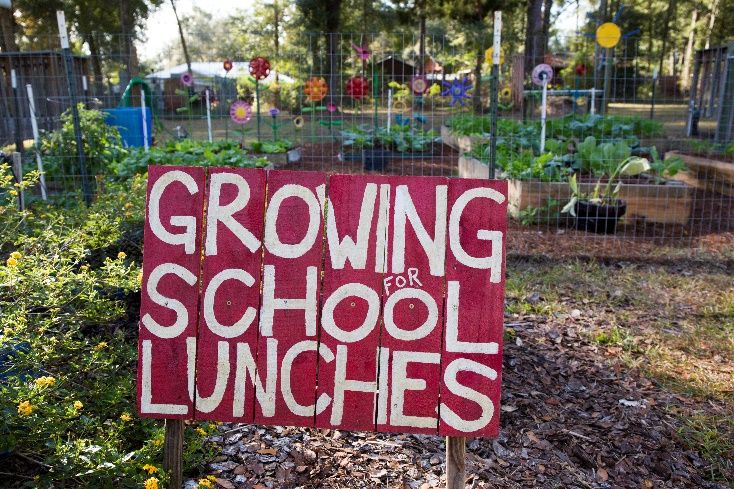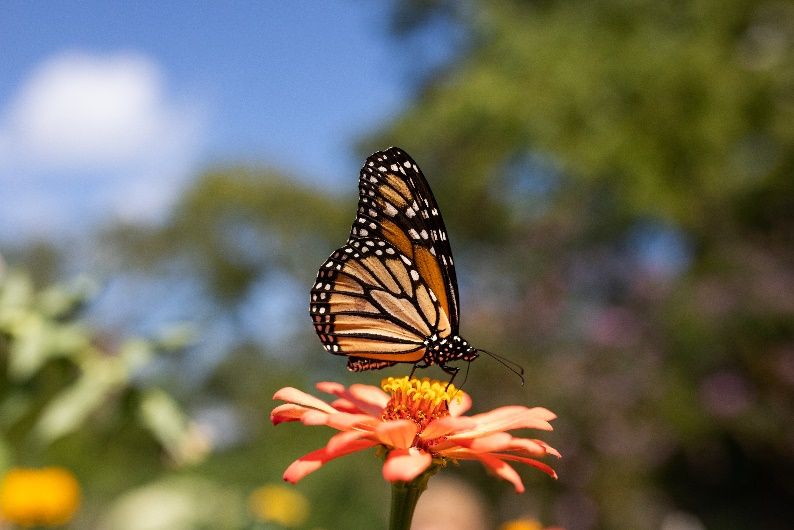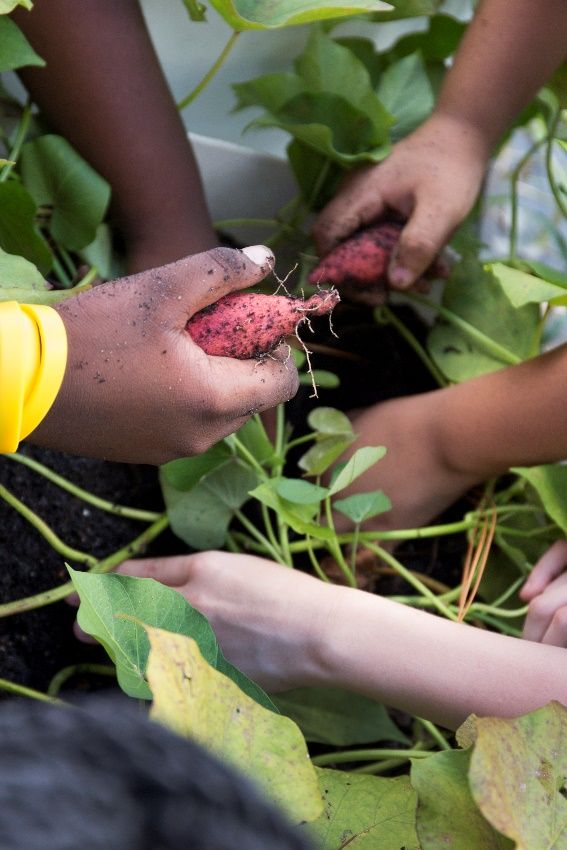Purpose: This publication highlights the potential benefits of urban gardens to immediate neighborhoods and the general urban community, as well as to residents of outlying communities and visitors to the city. City planners, residents, and community members will find it useful for planning new gardens and maintaining established gardens.
Introduction
Over 90 percent of Floridians live in urban areas. Owing to the rapid increase in urbanization, many people are disconnected from or have limited exposure to the natural world. Urban green spaces, among them urban gardens, can provide various benefits to people and wildlife. These urban gardens provide important avenues for people to maintain their mental and physical health, reduce stress, and improve their general well-being (Okvaut and Zauta 2011; Clarke et al. 2018). Urban gardens can include community gardens, private yard gardens, church gardens, and other types of food-producing green infrastructure. Urban gardening involves the cultivation and distribution of food in urban areas (usually excluding the production of animals). These urban gardens may include horticultural food production on patios, community gardens, private yards and homes, roofs, or public spaces.
The recent challenges of the COVID-19 pandemic further highlight the need to have more accessible urban green spaces like urban gardens (Lin et al. 2021). The pandemic has impacted people’s daily lives via social distancing mandates, quarantines, and overall impacts on our mental, physical, social, and emotional health. The impacts of the COVID-19 pandemic are unprecedented in the 21st century, and the pandemic experience has highlighted the importance of urban green spaces. Historically, urban gardening has been encouraged because of its social and economic benefits, especially during socio-economic downturns such as economic recessions and socio-political instability. For example, during World War II, the US government incentivized liberty gardens and victory gardens, which were public and private gardens, as a way to supplement food rations, reduce unemployment rates, boost morale and patriotism, and strengthen the US economy (Clarke et al. 2018; Lawson 2005). Likewise, gardening activity increased during the Great Depression and other economic recessions (Lawson 2005; Okvat and Zauta 2011). There is evidence that the number of urban gardens increase in response to socio-economic crises and decline in times of relative economic security, but many Communities of Color have consistently maintained urban food-producing gardens regardless of these economic shifts (Valle 2021). Community efforts to grapple with the evolving COVID-19 pandemic present an opportunity to reconsider the importance and many benefits of urban gardens. This publication is intended to assist Extension agents, gardeners, garden managers, and urban planners interested in adding new gardens and supporting and promoting existing gardens in Florida’s urban communities. To that end, it lists and explains 10 major benefits urban gardens provide to ecosystems and people.
Urban gardens build community resilience by helping citizens learn and adapt to challenges.
Urban gardens can build individuals’ and communities’ ability to learn, cope, and be more resilient. Gardens provide the space, resources, and support for people to connect with each other and learn from each other. The sharing of knowledge can be related to food production, cultural identities, politics, and overall inclusivity and belonging in a community. This can be facilitated by sharing resources and coming together for meetings, festivals, potlucks, cooking demonstrations, and other opportunities for community members to engage with and learn from each other. Urban gardens, especially community gardens, can facilitate participation and cooperative decision-making and help residents build a sense of community by providing a common space for them to gather, share information, and build social connections, friendships, and collaborations. The COVID-19 pandemic further highlights the critical need for urban green spaces like urban gardens. Residents used gardening as a coping mechanism. Their local green spaces, especially gardens, allowed people to spend time with their families, relieve stress, and socialize safely outdoors (Luo et al. 2021).
Furthermore, these urban gardens are known to facilitate cultural exchanges, encourage participation in neighborhood activities, and provide critical information about important community events. Neighbors connect and share gardening tips, of course, but also voting information, recipes, stories, advice, and strategies for everything from neighborhood safety concerns to childcare resources. In general, urban gardens give residents the opportunity to meet and create their community together.
Urban gardens increase food security.

Credit: Tyler Jones, UF/IFAS
Urban gardens can enhance food security in cities by providing fresh, healthy, and nutritious food (Opitz 2015). They can help to provide food in food deserts, which are areas that have limited access to fresh, nutritious, healthy, and affordable foods. Approximately 10 percent and 13.5 million people in the US census tracks are located within food deserts and lack access to a supermarket or large grocery store (Wright 2021). Food deserts are most prevalent in low-income communities and Communities of Color (Karpyn et al. 2020). Although there are initiatives to reduce food deserts, there is still growing concern, especially in low-income communities. Urban gardens like community gardens are linked to an increase in fruit and vegetable consumption, increased prioritization of cooking and shared family food preparations, and increased emphasis on consuming nutritious foods (Garcia et al. 2018). Urban gardens can enhance food security and reduce food deserts by providing access to fresh foods.
Gardens reduce the effects of urban heat islands.
Urban gardens can reduce urban heat island effects. Cities often experience heat islands because they are hotter than surrounding suburban or rural areas. The buildings and impervious surfaces in cities consume and reflect more heat than areas with green space, trees, and planted fields (Rizwan et al. 2008). Urban heat islands can worsen the human health problems created by air pollution and heat—respiratory impacts like asthma and heat-related illnesses like heat exhaustion and heat stroke. For the last 30 years, extreme heat has been the primary cause of weather-related deaths in the United States (National Oceanic and Atmospheric Administration 2023). Urban heat islands are more prevalent in low-income areas and Communities of Color (Hsu et al. 2021) and have significant effects on populations that are already vulnerable to various social and environmental stressors. A national study of sixty US cities found that heat is not equally distributed in urban areas and that poor communities are usually hotter than wealthier communities with tree-lined streets and large yards, a phenomenon that usually stems from the legacy of redlining (discriminatory lending practices) and housing discrimination (National Oceanic and Atmospheric Administration 2023). The inequitable distribution of urban green spaces and urban heat islands can put vulnerable populations at increased risk of respiratory illnesses, including asthma, which is more common in low-income communities and Communities of Color than in the general American population (US Environmental Protection Agency 2023). Urban gardens and other types of vegetation in urban areas can help to reduce the urban heat island effects, however, because plants and soil cool their environments via evapotranspiration. In evapotranspiration, water evaporates from plants and soil, transferring cooling moisture to the surrounding area. Further, the shade from trees and shrubs reduces heat absorption (Kleerekoper et al. 2012; Mancebo 2018).
Urban gardens increase wildlife habitats in cities.

Credit: Cristina Carriz, UF/IFAS
Urban gardens are well documented to benefit wildlife. Gardens increase wildlife habitat and give many desirable species the spaces they need to survive. Gardens help wildlife migrate to and live in urban areas. Gardens foster and increase biodiversity in cities in many ways, including by providing habitats for various pollinators (Majewska and Altizer 2020), which may also increase plant diversity in urban areas. Urban gardens like community gardens can attract various pollinators because of their plant diversity and low pesticide use (Tasker et al. 2020). Pollinator-friendly gardens can provide invaluable opportunities for pollinators such as the endangered monarch butterfly (Danaus plexippus) to find food, nests, host plants, and shelter (Figure 2). Urban gardens benefit not only their immediate environs but entire regions because they help to reduce runoff of environmental pollutants after rain (Richards et al. 2015; Malaviya et al. 2019). In this way, urban gardens may benefit the many aquatic species that are impacted by runoff by reducing nutrient runoff, indirectly benefiting vulnerable aquatic species like the West Indian manatee (Trichechus manatus), and they may even reduce the buildup of nutrients that leads to dangerous algal blooms.
Urban gardens improve community responses to natural disasters, reduce storm damage, and speed environmental recovery.
Urban gardens like community gardens can be a refuge for residents after disaster events. For example, urban community gardens serve as a gathering space for residents after a hurricane to communally process the event, share information, and find support (Chan et al. 2015). Stormwater management is a significant challenge in many urban environments. It is particularly important in Florida’s cities because of Florida’s frequent storms and heavy rains and subsequent flooding. Effectively designed community gardens intentionally incorporated in urban areas can reduce stormwater runoff by mitigating flooding and water pollution. These urban gardens may include rain gardens and flower- and fruit-producing gardens that help to filter sediments and pollutants from the water. Gardens also absorb rainwater via the soil and through the plants’ roots and other plant parts, all while helping to replenish groundwater by absorbing rainfall and allowing water to trickle back through the soil into the aquifer (U.S. EPA 2015). Urban gardens may also help to reduce the damage from storms by buffering wind and reducing runoff and pollutants that end up in waterways.
Urban gardens provide various cultural services.
The cultural services ecosystems like gardens and urban green spaces provide are the non-material benefits that people can get from those ecosystems (Camps-Calvet et al. 2016). Urban gardens provide people with spaces to practice spirituality, foster a sense of identity, and experience belonging within their communities, as well as many recreation, relaxation, and ecotourism opportunities (Okvat and Zauta, 2011).
Urban gardens provide employment.
Urban gardens can provide employment opportunities for various people in cities including urban farmers and other stakeholders in the food supply chain (Azunre et al. 2020; Lawson 2005). Employment opportunities in urban gardens will of course vary depending on the size, purpose, location, and production use of each garden. Employment opportunities may also vary on a scale from voluntary unpaid to full-time paid positions as maintenance workers, harvesters, managers, and vendors, among others.
Urban gardens enhance climate change adaptation.
Urban gardens can help communities adapt to climate change by reducing carbon emissions associated with food production and transportation and by enhancing carbon sequestration. Urban gardens can sequester carbon by increasing vegetation in urban areas. For example, a study of community gardens found that over 150,000 tons of carbon was sequestered by 10,000 gardens in the United States (Okvat and Zauta 2011).

Credit: Tyler Jones, UF/IFAS
Urban gardens increase environmental literacy, especially for children.
Environmental literacy refers to people’s ability to understand and make well-informed decisions about how the environment interacts with urban areas. Because most people in the United States, including most Floridians, live in urban areas, many residents’ first interaction with nature comes from green spaces in urban areas such as urban community gardens. Many children will first experience nature in green spaces in their own cities, urban gardens among them. While today’s children are more connected through technology than children of previous generations, they are also less connected to nature than children were in the past (House et al. 2016). This disconnect with nature is known as the “nature deficit.” Research has shown that this disconnect can increase health issues for children. Obesity and attention disorders, for example, are associated with disconnection from nature (Louv 2005). Urban gardens provide spaces where children can learn about food production. They provide a place to play and participate in recreational activities, develop social skills, observe wildlife, and learn about the environment.
Urban gardens improve human health and well-being.
Urban gardens can provide spaces to enhance and maintain people’s health and well-being. These gardens are often used as a space to relieve stress and improve physical health. For example, digging, planting, and harvesting provides numerous health benefits by engaging various muscles. Being physically active can also help to reduce the risk of chronic illnesses like obesity and diabetes. Direct exposure to natural spaces can help to prevent diseases and improve people’s health outcomes.
Conclusion
Urban gardens provide many and varied social and ecological benefits to society. In addition to beautifying cities and providing spaces to enjoy the outdoors, they also provide other practical uses that can enhance cities’ resilience during economic, political, or social instability such as recessions and the recent COVID-19 global pandemic. Despite the numerous benefits of urban and community gardens, funding and resources for residents to design, develop, install, and maintain them have been limited historically. More outreach and dedicated Extension programs should be provided to increase the number of urban and community gardens in Florida. More urban green spaces, including urban gardens, are needed because they provide the ten benefits listed below.
- Urban gardens build a community’s ability to learn and adapt
- Enhance food security
- Reduce the effects of urban heat islands
- Increase wildlife habitats in urban areas
- Improve responses to natural disasters
- Provide various cultural services
- Provide employment
- Enhance climate change adaptation
- Increase environmental literacy
- Enhance human health and well-being
References
Azunre, G. A., O. Amponsah, C. Peprah, S. A. Takyi, and I. Braimah. 2019. “A Review of the Role of Urban Agriculture in the Sustainable City Discourse.” Cities 93:104–119. https://doi.org/10.1016/j.cities.2019.04.006
Camps-Calvet, M., J. Langemeyer, L. Calvet-Mir, and E. Gómez-Baggethun. 2016. “Ecosystem Services Provided by Urban Gardens in Barcelona, Spain: Insights for Policy and Planning.” Environmental Science & Policy 62:14–23. https://doi.org/10.1016/j.envsci.2016.01.007
Chan, J., B. Dubois, and K. G. Tidball. 2015. “Refuges of Local Resilience: Community Gardens in Post-Sandy New York City.” Urban Forestry & Urban Greening 14 (3): 625–635. https://doi.org/10.1016/j.ufug.2015.06.005
Clarke, M., M. Davidson, M. Egerer, E. Anderson, and N. Fouch. 2018. “The Underutilized Role of Community Gardens in Improving Cities' Adaptation to Climate Change: A Review.” People, Place and Policy 12(3). https://doi.org/10.3351/ppp.2019.3396732665
Garcia, M. T., S. M. Ribeiro, A. C. C. G. Germani, and C. M. Bógus. 2018. “The Impact of Urban Gardens on Adequate and Healthy Food: A Systematic Review.” Public Health Nutrition 21 (2): 416–425. https://doi.org/10.1017/S1368980017002944
House, E., C. O'Connor, K. Wolf, J. Israel, and T. Reynolds. 2016. “Outside Our Doors: The Benefits of Cities Where People and Nature Thrive.” Seattle, WA: The Nature Conservancy, Washington State Chapter, 30 pp.
Hsu, A., G. Sheriff, T. Chakraborty, and D. Manya. 2021. “Disproportionate Exposure to Urban Heat Island Intensity across Major US Cities.” Nature Communications 12 (1): 1–11. https://doi.org/10.1038/s41467-021-22799-5
Kleerekoper, L., M. Van Esch, and T. B. Salcedo. 2012. “How to Make a City Climate-Proof, Addressing the Urban Heat Island Effect.” Resources, Conservation and Recycling 64:30–38. https://doi.org/10.1016/j.resconrec.2011.06.004
Karpyn, A. E., D. Riser, T. Tracy, R. Wang, and Y. E. Shen. 2019. “The Changing Landscape of Food Deserts.” UNSCN Nutrition 44:46.
Lal, R. 2020. “Home Gardening and Urban Agriculture for Advancing Food and Nutritional Security in Response to the COVID-19 Pandemic.” Food security 12 (4): 871–876. https://doi.org/10.1007/s12571-020-01058-3
Lawson, L. J. 2005. City Bountiful: A Century of Community Gardening in America. Berkeley and Los Angeles, CA: University of California Press.
Lin, B. B., M. H. Egerer, J. Kingsley, P. Marsh, L. Diekmann, and A. Ossola. 2021. “COVID‐19 Gardening Could Herald a Greener, Healthier Future.” Frontiers in Ecology and the Environment 19 (9): 491. https://doi.org/10.1002/fee.2416
Louv, R. 2005. Last Child in the Woods: Saving Our Children from Nature-deficit Disorder. Chapel Hill, NC: Algonquin Books of Chapel Hill.
Luo, S., J. Xie, and K. Furuya. 2021. “‘We need such a space”: Residents’ Motives for Visiting Urban Green Spaces during the COVID-19 Pandemic.” Sustainability 13 (12): 6806. https://doi.org/10.3390/su13126806
Malaviya, P., R. Sharma, and P. K. Sharma. 2019. Rain gardens as stormwater management tool. Sustainable Green Technologies for Environmental Management 141–166. https://doi.org/10.1007/978-981-13-2772-8_7
Majewska, A. A., and S. Altizer. 2020. “Planting Gardens to Support Insect Pollinators.” Conservation Biology 34 (1): 15–25. https://doi.org/10.1111/cobi.13271
National Oceanic and Atmospheric Administration (NOAA). (2023, April 4). NOAA, communities to map heat inequities in 14 states, 1 International City. https://www.noaa.gov/news-release/noaa-communities-to-map-heat-inequities-in-14-states-1-international-city. Accessed July 25, 2023.
Okvat, H., and A. Zauta. 2011. “Community Gardening: A Parsimonious Path to Individual, Community, and Environmental Resilience.” American Journal of Community Psychology 47 (3-4): 374–387. https://doi.org/10.1007/s10464-010-9404-z
Opitz, I., R. Berges, A. Piorr, and T. Krikser. 2016. “Contributing to Food Security in Urban Areas: Differences between Urban Agriculture and Peri-Urban Agriculture in the Global North.” Agriculture and Human Values 33 (2): 341–358. https://doi.org/10.1007/s10460-015-9610-2
Mancebo, F. 2018. “Gardening the City: Addressing Sustainability and Adapting to Global Warming through Urban Agriculture.” Environments 5 (3): 38. https://doi.org/10.3390/environments5030038
Richards, P. J., C. Farrell, M. Tom, N. S. Williams, and T. D. Fletcher. 2015. “Vegetable Raingardens Can Produce Food and Reduce Stormwater Runoff.” Urban Forestry & Urban Greening, 14 (3): 646–654. https://doi.org/10.1016/j.ufug.2015.06.007
Rizwan, A. M., L. Y. Dennis, and L. I. U. Chunho. 2008. “A Review on the Generation, Determination, and Mitigation of Urban Heat Island.” Journal of Environmental Sciences 20 (1): 120–128. https://doi.org/10.1016/S1001-0742(08)60019-4
Tasker, P., C. Reid, A. D. Young, C. G. Threlfall, and T. Latty. 2020. “If you plant it, they will come: quantifying attractiveness of exotic plants for winter-active flower visitors in community gardens.” Urban Ecosystems 23 (2): 345–354. https://doi.org/10.1007/s11252-019-00914-1
Valle, G. R. 2021. “The Past in the Present: What Our Ancestors Taught Us about Surviving Pandemics.” Food ethics 6 (2): 1–12. https://doi.org/10.1007/s41055-021-00088-7
United States Environmental Protection Agency (EPA). 2023. Heat Islands and Equity. https://www.epa.gov/heatislands/heat-islands-and-equity. Accessed July 24, 2024.
US EPA. 2015. “Green Infrastructure and Ground Water Impacts.” Accessed July 24, 2024. https://www.epa.gov/green-infrastructure/green-infrastructure-and-ground-water-impacts
World Bank. 2013. “Urban Agriculture: Findings from Four City Case Studies.” Urban development series knowledge papers No. 18 (Washington DC).
Wright, A. 2021. “Interactive web tool maps food deserts, provides key data.” USDA. Retrieved December 4, 2022, from https://www.usda.gov/media/blog/2011/05/03/interactive-web-tool-maps-food-deserts-provides-key-data